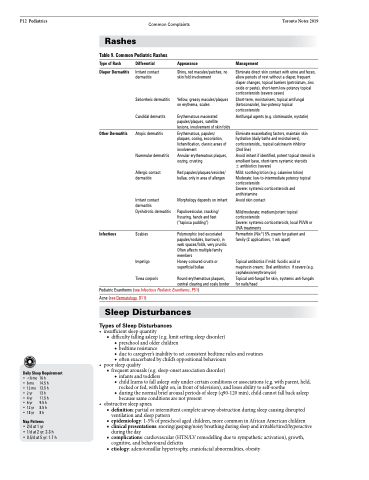Page 1046 - TNFlipTest
P. 1046
P12 Pediatrics
Common Complaints
Toronto Notes 2019
Rashes
Table 9. Common Pediatric Rashes
Type of Rash
Diaper Dermatitis
Other Dermatitis
Differential
Irritant contact dermatitis
Seborrheic dermatitis Candidal dermatits
Atopic dermatitis
Nummular dermatitis
Allergic contact dermatitis
Irritant contact dermatitis Dyshidrotic dermatitis
Scabies
Impetigo Tinea corporis
Appearance
Shiny, red macules/patches, no skin fold involvement
Yellow, greasy macules/plaques on erythema, scales
Erythematous macerated papules/plaques, satellite lesions, involvement of skin folds
Erythematous, papules/ plaques, oozing, excoriation, lichenification, classic areas of involvement
Annular erythematous plaques, oozing, crusting
Red papules/plaques/vesicles/ bullae, only in area of allergen
Morphology depends on irritant
Papulovesicular, cracking/ fissuring, hands and feet (“tapioca pudding”)
Polymorphic (red excoriated papules/nodules, burrows), in web spaces/folds, very pruritic Often affects multiple family members
Honey-coloured crusts or superficial bullae
Round erythematous plaques, central clearing and scaly border
Management
Eliminate direct skin contact with urine and feces, allow periods of rest without a diaper, frequent diaper changes, topical barriers (petrolatum, zinc oxide or paste), short-term low-potency topical corticosteroids (severe cases)
Short-term, moisturisers, topical antifungal (ketoconazole), low-potency topical corticosteroids
Antifungal agents (e.g. clotrimazole, nystatin)
Eliminate exacerbating factors, maintain skin hydration (daily baths and moisturisers), corticosteroids,, topical calcineurin inhibitor (2nd line)
Avoid irritant if identified, potent topical steroid in emollient base, short-term systemic steroids
± antibiotics (severe)
Mild: soothing lotion (e.g. calamine lotion) Moderate: low-to-intermediate potency topical corticosteroids
Severe: systemic corticosteroids and antihistamine
Avoid skin contact
Mild/moderate: medium/potent topical corticosteroids
Severe: systemic corticosteroids, local PUVA or UVA treatments
Permethrin (Nix®) 5% cream for patient and family (2 applications, 1 wk apart)
Topical antibiotics if mild: fucidic acid or mupirocin cream; Oral antibiotics if severe (e.g. cephalexin/erythromycin)
Topical anti-fungal for skin, systemic anti-fungals for nails/head
Infectious
Pediatric Exanthems (see Infectious Pediatric Exanthems, P51)
Acne (see Dermatology, D11)
Sleep Disturbances
Types of Sleep Disturbances
• insufficientsleepquantity
■ difficulty falling asleep (e.g. limit setting sleep disorder)
Daily Sleep Requirement
• <6 mo 16 h
◆ preschool and older children
◆ bedtime resistance
◆ due to caregiver’s inability to set consistent bedtime rules and routines ◆ often exacerbated by child’s oppositional behaviours
• poorsleepquality
■ frequent arousals (e.g. sleep-onset association disorder)
◆ infants and toddlers
◆ child learns to fall asleep only under certain conditions or associations (e.g. with parent, held,
rocked or fed, with light on, in front of television), and loses ability to self-soothe
◆ during the normal brief arousal periods of sleep (q90-120 min), child cannot fall back asleep
because same conditions are not present • obstructivesleepapnea
■ definition:partialorintermittentcompleteairwayobstructionduringsleepcausingdisrupted ventilation and sleep pattern
■ epidemiology:1-5%ofpreschoolagedchildren,morecommoninAfricanAmericanchildren
■ clinical presentations: snoring/gasping/noisy breathing during sleep and irritable/tired/hyperactive
during the day
■ complications: cardiovascular (HTN/LV remodelling due to sympathetic activation), growth,
cognitive, and behavioural deficitis
■ etiology: adenotonsillar hypertrophy, craniofacial abnormalities, obesity
•6mo • 12 mo •2yr •4yr •6yr •12yr •18yr
14.5h 13.5 h 13h 11.5 h 9.5 h 8.5h 8h
NapPatterns
• 2/d at 1 yr
• 1/d at 2 yr: 2-3 h
• 0.5/d at 5 yr: 1.7 h


